Nestled in the heart of Birmingham, Alabama’s historic Glen Iris neighborhood, this grand Greek Revival mansion serves as a captivating time capsule, echoing the stories of its 120-year existence. With a rich past that includes hosting distinguished figures like a former FBI agent, the residence has seen both joyous moments and heart-wrenching tragedies unfold within its walls. The estate, frozen in time, preserves the memories of its previous occupants through an array of personal items, antique treasures, and even a deteriorating wedding dress.
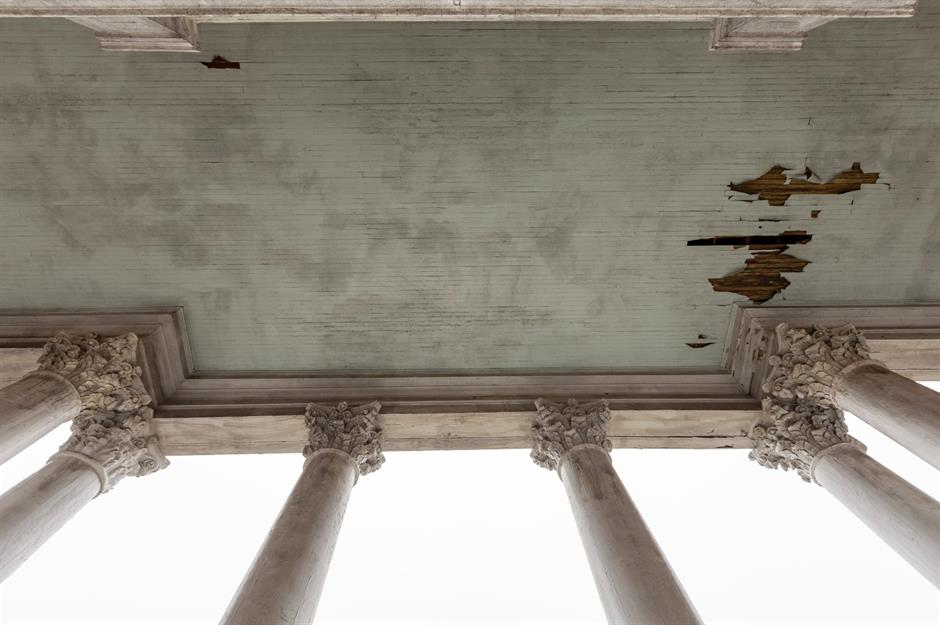
Despite the wear and tear it has endured, the mansion’s exterior continues to make a strong first impression. Its two-story wraparound porch, commanding portico, and fourteen Corinthian columns, designed by Thomas Walter III, the grandson of the architect behind the iconic dome of the US Capitol building, still exude a commanding presence. Leland Kent’s photographs on the Abandoned Southeast site reveal the peeling paint and weathered wood, highlighting the toll of neglect on the once-majestic structure.
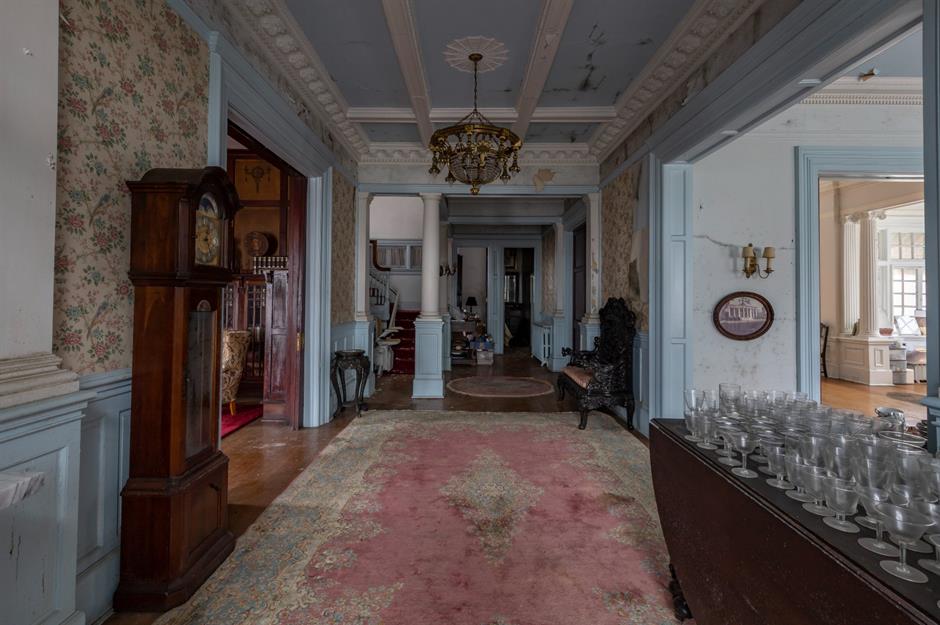
Stepping into the entrance hall is like entering a time machine, transporting visitors back to the year 1902 when the mansion was first built. The opulent interior, adorned with a coffered ceiling, internal columns, and neoclassical-style doorways, creates a palatial atmosphere. An antique grandfather clock stands frozen, a silent witness to the passage of time. The theatrical touches in the design, credited to Sidney Ullman, who collaborated with architect Walter and later worked as an art director for early Hollywood films, add a layer of historical charm.
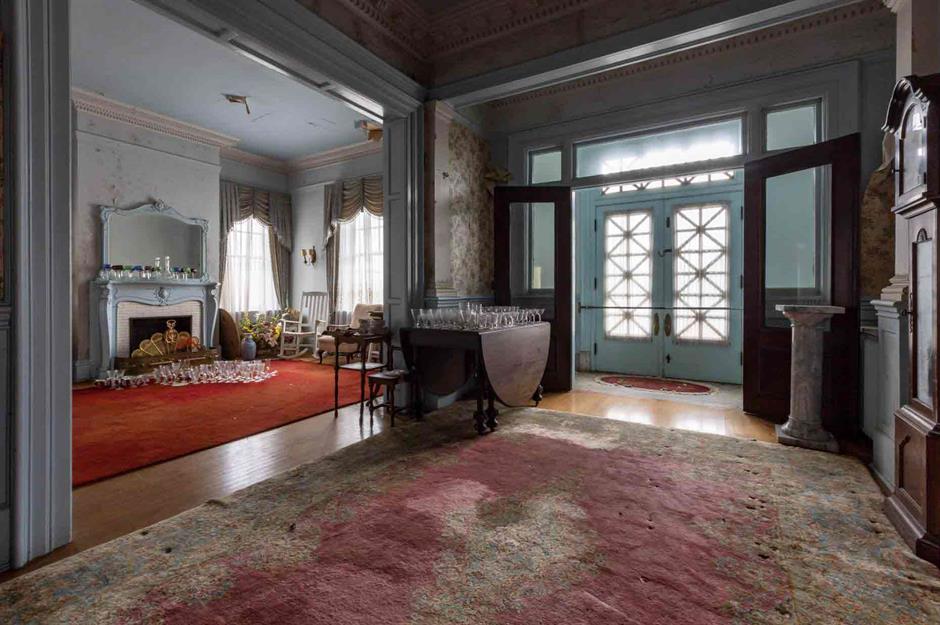
A glance back towards the entrance doors reveals an elegant marble half-column and a polished wooden folding table adorned with an array of fancy glasses, reminiscent of a bygone era’s soirée or perhaps an estate sale. Originally constructed for Lee Carrington Bradley, a prominent lawyer in the city, the mansion tells the tale of Birmingham’s history through the lens of the Bradley family, pioneers in Alabama with roots dating back to the late 19th century.
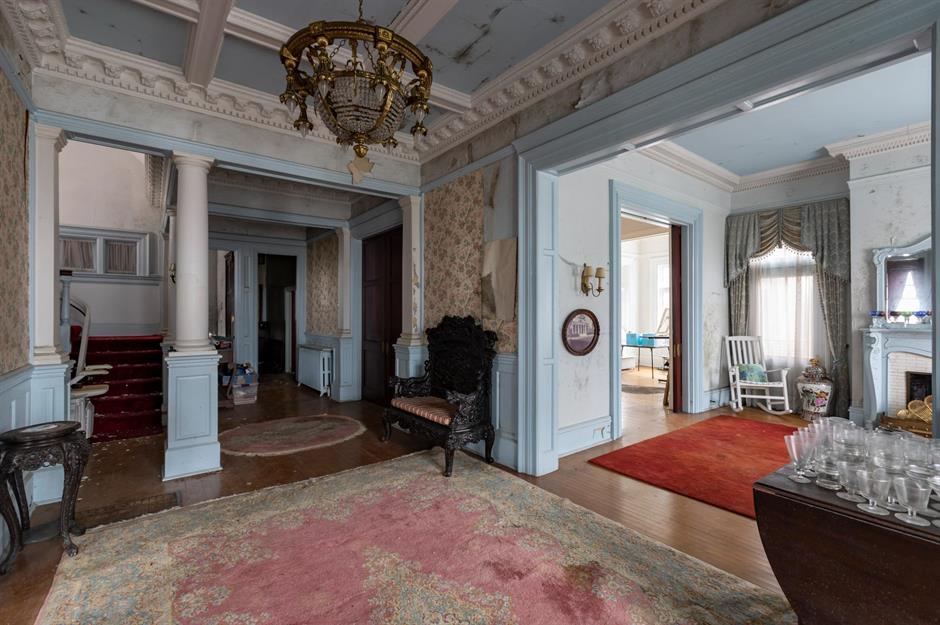
As you step into the living areas from the hallway, a sense of spacious elegance surrounds you. The large gold chandelier, adorned with crystal beading at its center, adds a touch of glamour, casting shimmering light throughout the space. However, against this backdrop of opulence, the torn and ripped wallpaper serves as a poignant reminder of the mansion’s aging grandeur.
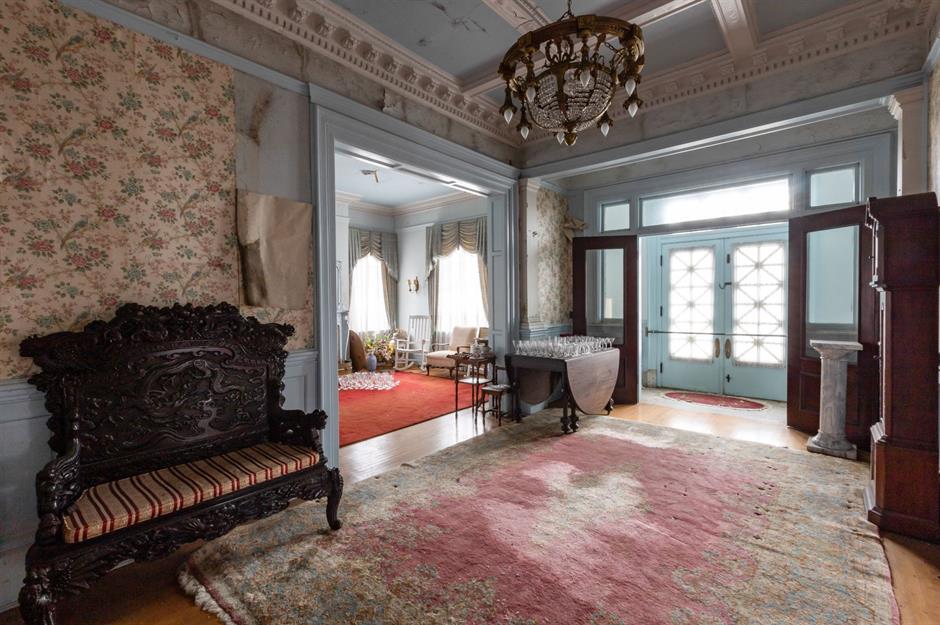
Take a moment to appreciate the eye-catching loveseat in the hallway, featuring an East Asian design with sinuous dragon carvings on the dark wood. The antique rug beneath it, though faded and worn, adds to the overall aesthetic. Elaborate cornicing on the ceiling adds a touch of architectural splendor. In 1896, Lee Bradley, a central figure in the community, married Eleanor Lyons. Their first child, Lee Carrington Bradley, Jr., was born in 1897, followed by a second child, Thomas Lyons Bradley, in 1899.

Tragically, Thomas’s life was cut short at the age of 21. While visiting home from college, he choked on oyster shell shards at the kitchen table, as recounted by Leland Kent. This family tragedy left a lasting impact, with Thomas’s mother continuing to set a place for him at the dining table until her passing in 1967. In this view, you can closely observe the impressive interior columns, as well as a stair-lift chair—a more recent addition reflecting the needs of an aging former resident.
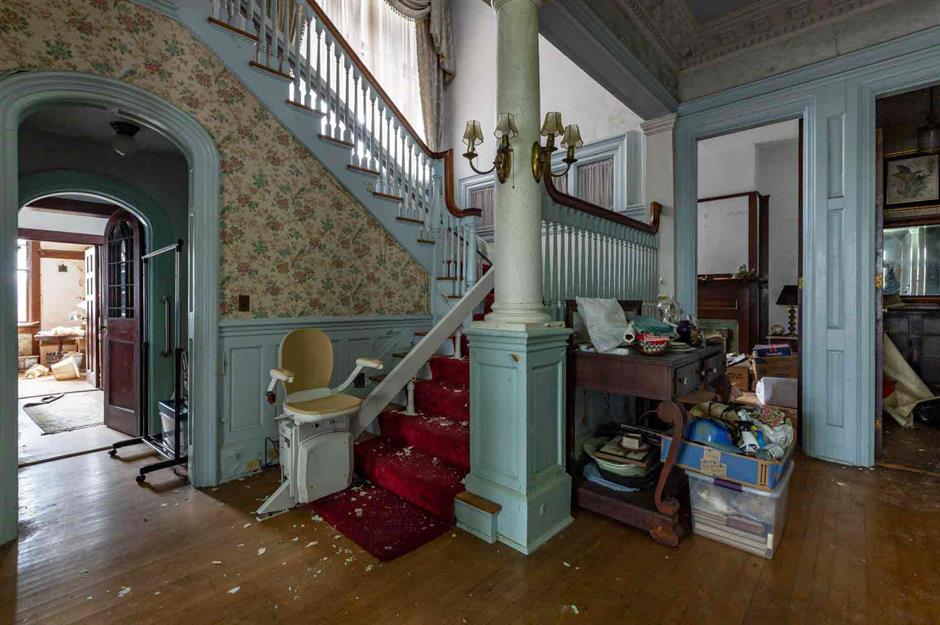
From this perspective, remnants of past lives in the house become apparent. Quirkily mounted light fittings on a stair column hint at the eclectic touches left behind by previous owners. Despite the family tragedies, Lee’s professional journey continued to ascend, culminating in the establishment of his own law firm, Tillman, Grubb, Bradley & Morrow, in 1904, as documented by Leland Kent.
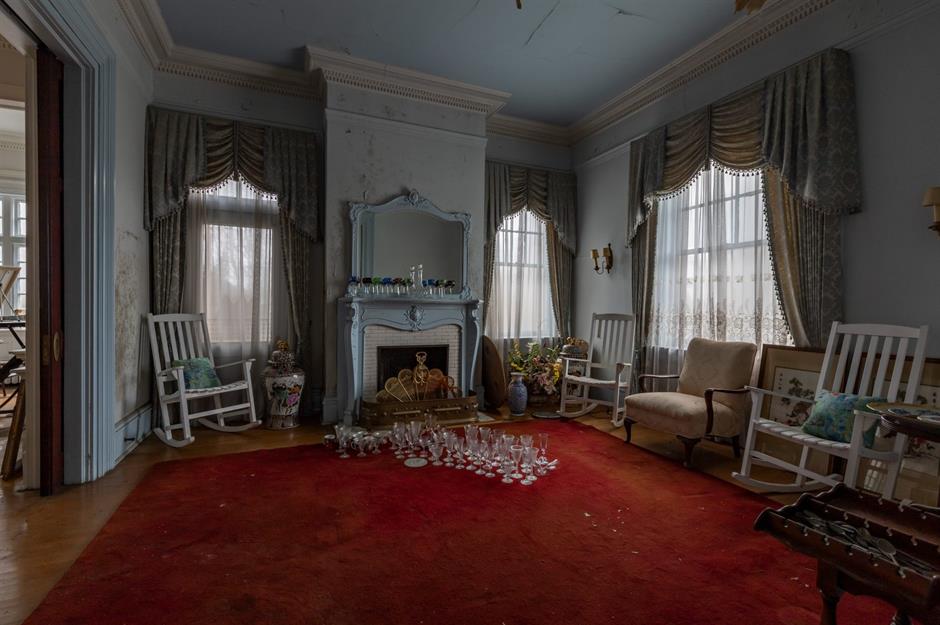
The living room boasts an impressive fireplace that serves as a focal point, drawing inspiration from the ornate Baroque design style. Tall windows, draped with sweeping curtains, contribute to the old-world drama of the interior. A golden fantail fireguard and an oversized antique vase add further opulence. However, the room’s grandeur is overshadowed by dampness on the walls, water stains on the rug, and large sections of peeling ceiling. In front of the fireplace, crystal glasses are strewn across the floor, as if arranged for cleaning, creating an air of mystery.
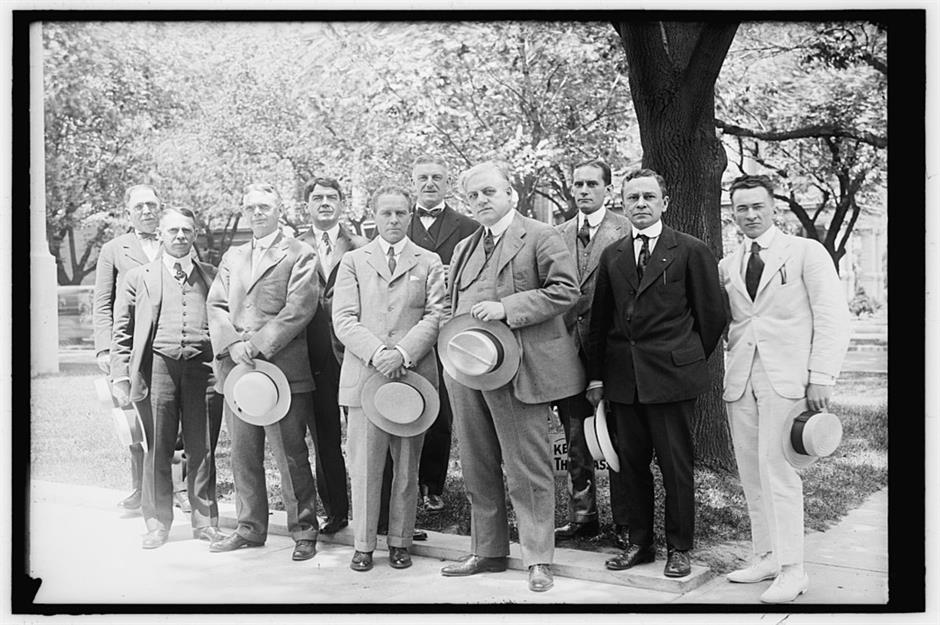
Lee’s reputation as a successful lawyer extended beyond Alabama and reached President Woodrow Wilson, who appointed him supervising attorney for the United States Alien Property Custodian department. A 1918 photograph captures Lee (third from the left) with his colleagues. The department’s mission during the First World War was to confiscate and hold assets of enemies of the USA.
RECOMMENDED: Mysterious Abandoned Mansion Rumoured To Be Built On Gold
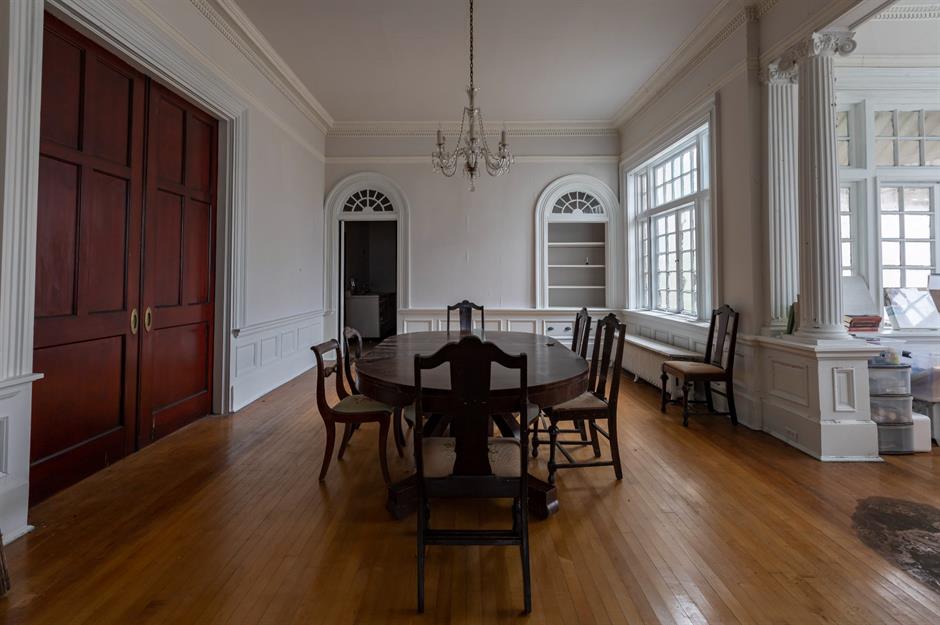
Visualize Lee engaged in important affairs within the stately dining room, characterized by muted colors and classical-style columns. The semi-circular transom window above an arched internal doorway cleverly mirrors the adjacent shelving unit design, showcasing the pleasing symmetry typical of neoclassical style.
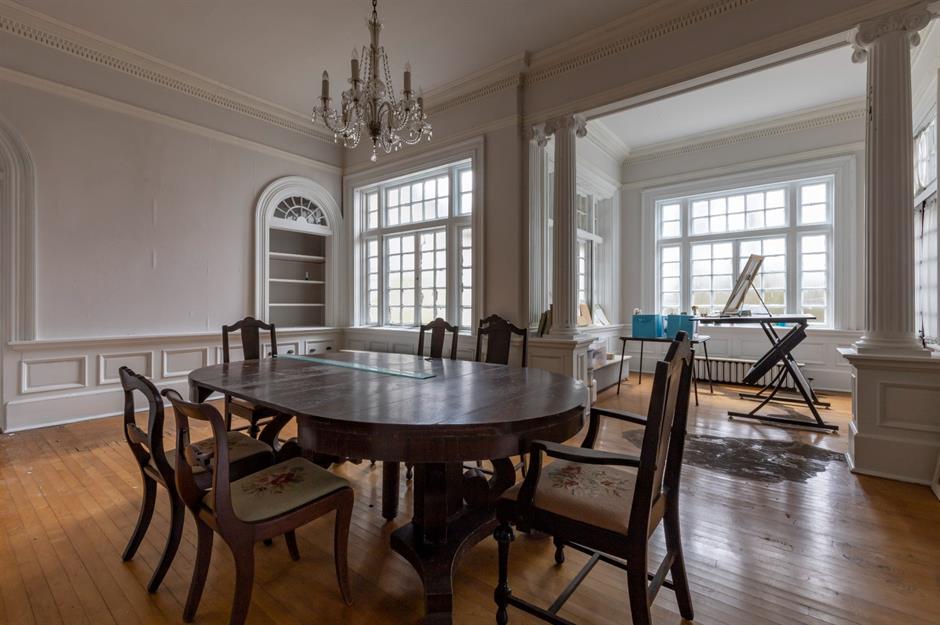
Lee left his mark in his high-profile role by proposing legislation that allowed his department to sell or dispose of perishable property, preventing it from languishing in warehouses, according to Abandoned Southeast. From this perspective, you can observe an impressive bay window, suggesting that a recent visitor took advantage of the abundant natural light, setting up an artist’s easel to capture the scene.
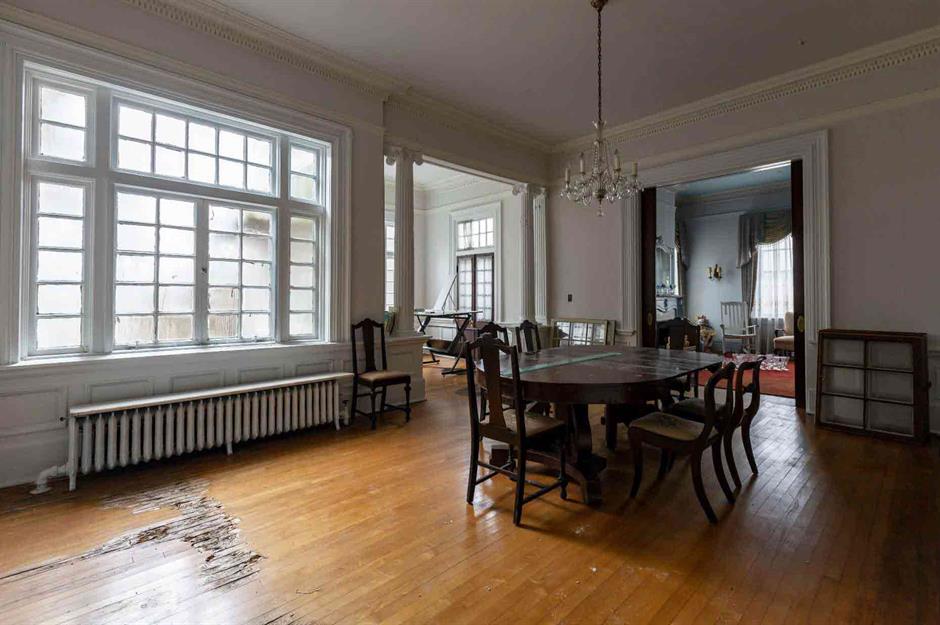
In contrast to some of the more contemporary additions found in the abandoned mansion, the miniature radiator shown here manages to blend seamlessly with the classical design. However, the once-smart wooden floor now bears extensive water damage, possibly from a leak connected to the mentioned radiator. Returning from the bustling political capital, Lee resumed his law practice and took on the role of receiver for the struggling Birmingham Railway, Light & Power Company. Under his guidance, the company underwent a successful transformation into the more robust Birmingham Electric Company.
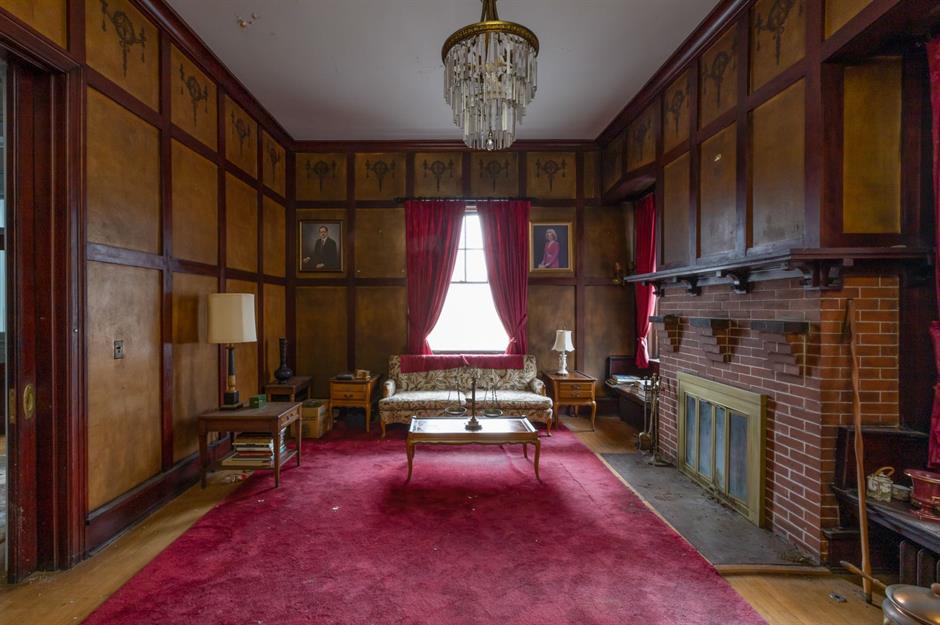
Take a moment to appreciate this charming wood-paneled living room adorned with neoclassical-style motifs on the top panels. The fireplace exudes a rustic, mid-century vibe distinct from the baroque flourishes seen in the living room, hinting at a more modern addition. The lavish Art Deco-style chandelier, with pendant crystals catching the light, adds a touch of glamour. Lee’s dynamic professional life continued as he served as the director of Birmingham Savings Bank & Trust Company for four decades and held stock in Birmingham’s baseball club.

This space, adorned with cases of books, appears to have served as a reading room. Antique oddities, including old-fashioned weighing scales and a pair of cowboy figurines, embellish the table and floor. Upon Lee’s passing in 1942, his funeral took place in the house, and he was laid to rest in Elmwood Cemetery alongside the rest of the Bradley family.
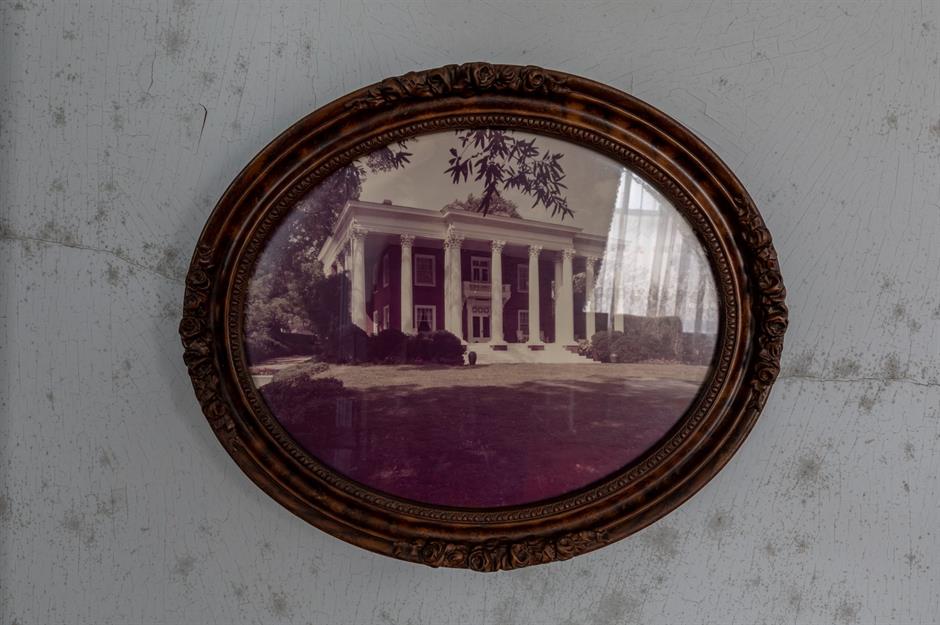
A glimpse into the mansion’s heyday is captured in this photograph hanging in the living room, providing a nostalgic look back before decay took hold of the abandoned building. Note the speckles of water damage and cracks on the wall surrounding the photo. Following Lee’s death, the house changed hands and was purchased by Ollie Dalton Smith and his wife, Carolyn.
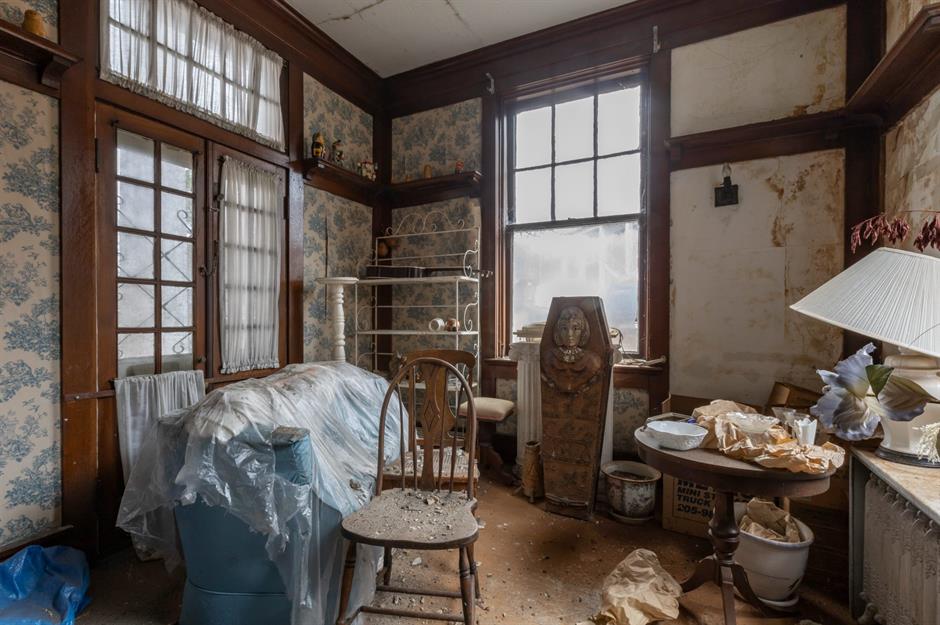
Adding to the roster of notable residents in the mansion, Ollie Smith embarked on his career as the youngest FBI agent in the Washington, DC office before completing his education at the University of Alabama School of Law in 1947. This intriguing space, with its irregular shape and glass-lined doors, might have served as a sunroom. The pretty blue and white wallpaper enhances its light and bright ambiance, and an eye-catching Egyptian sarcophagus-style ornament against the window adds a touch of exotic flair. Though more reminiscent of a theatrical prop than a genuine artifact, it features a stylized woman’s head with illustrations below.
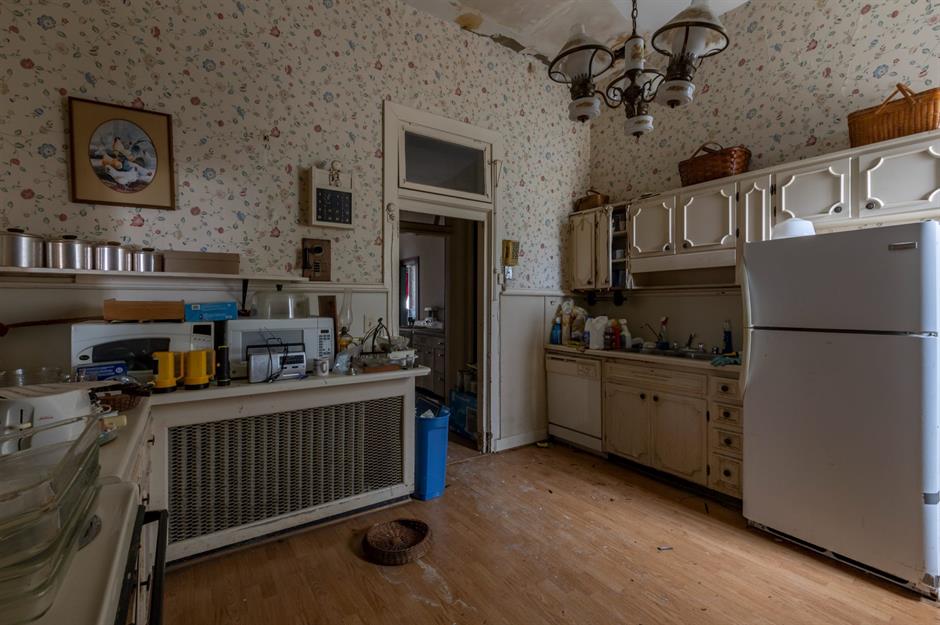
The kitchen, unfortunately, presents a stark contrast with its dilapidated state – the ceiling is crumbling, and light fixtures show signs of rust. An old-fashioned intercom system on the far wall hints at a bygone era, possibly used for residents to place food orders from the comfort of their sofa or bed. Ollie and his wife, Carolyn Meadows, raised four children in this household, making it a likely bustling hub during their time here. Carolyn, initially a teacher at Tarrant High School and Shades Valley High School, later took charge of the family’s real estate business, as noted by Abandoned Southeast.
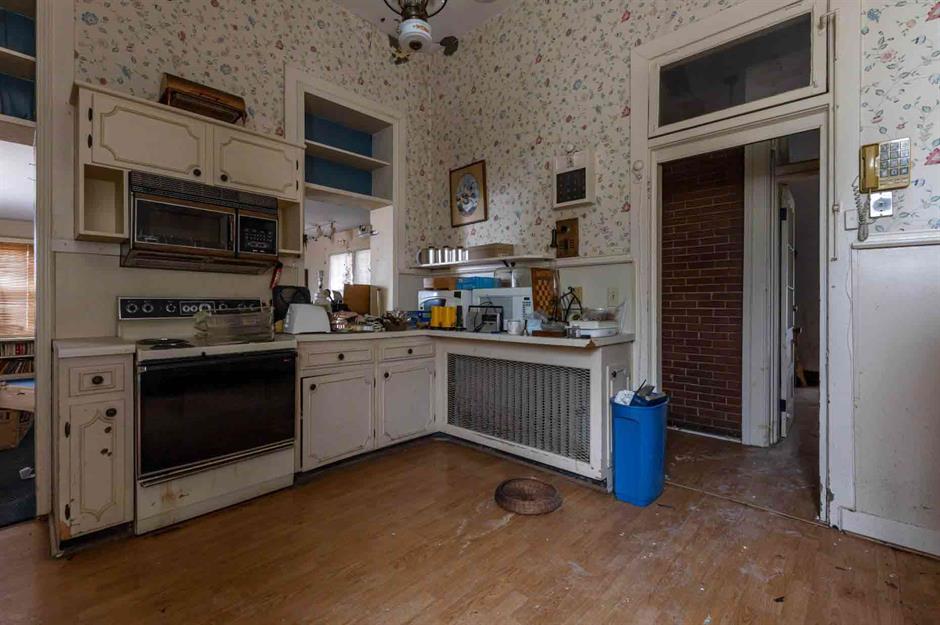
An odd grate covers one of the lower units in the dated kitchen, possibly serving as the top of a heater. The cooker stands as a relic from yesteryear, its cream color scheme and delicate floral wallpaper exuding a certain charm.
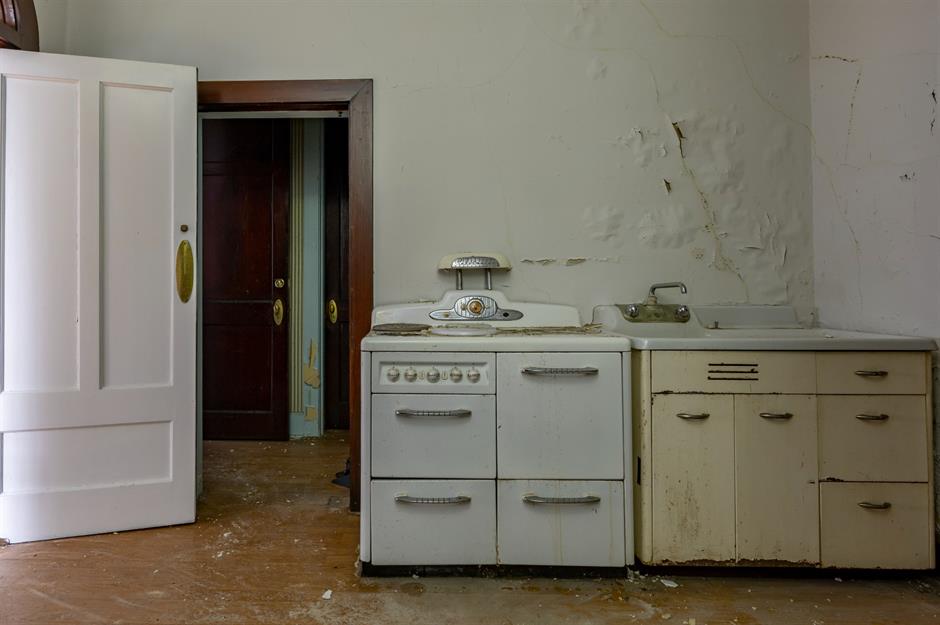
These old-fashioned units evoke a sense of nostalgia, though their wear and tear is evident. The walls, suffering from condensation and dampness, tell a story of the challenges faced by the aging mansion. Following in the footsteps of his predecessor in the house, Ollie Smith pursued a legal career, practicing law at the Alabama firm Martin, Turner & McWhorter, later known as Balch & Bingham.
RECOMMENDED: Tour This $25M Abandoned Mansion In Toronto With A Secret Bunker
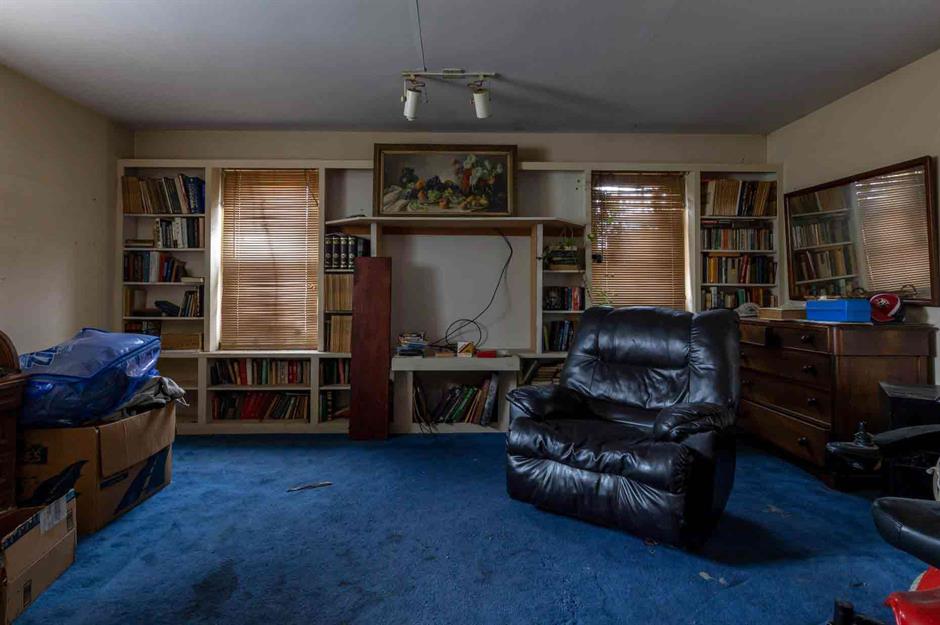
This room appears to have been an entertainment space, featuring a large, comfortable sofa chair inviting one to snuggle down. Its design is notably basic, with utilitarian blinds and light fixtures, marking a departure from the ornate flourishes seen in other living areas. The only decorative touch is a still-life oil painting. In the later stages of his career, Smith took on roles as manager and later vice-president of the Land Department for the Alabama Power Company.
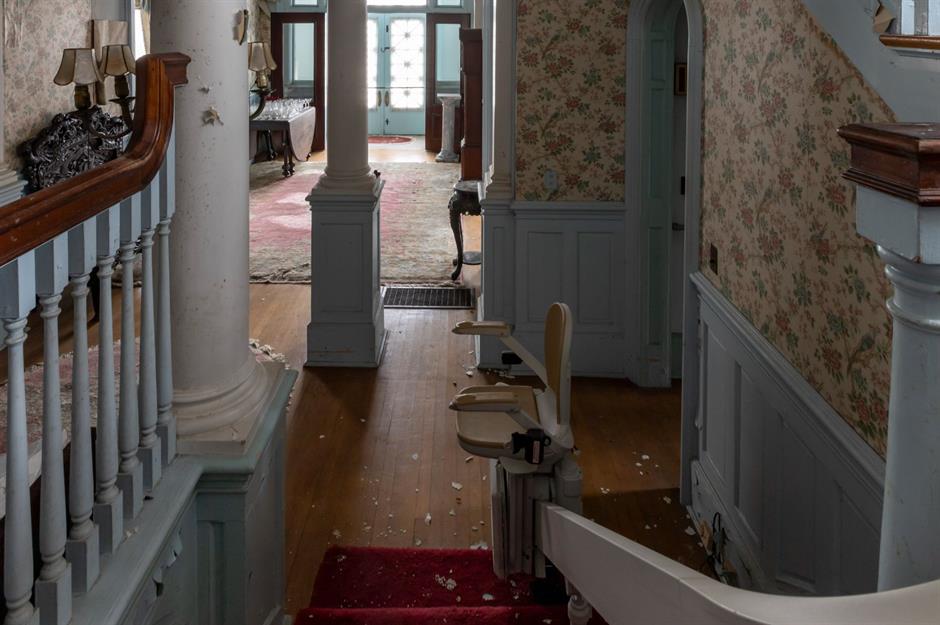
In addition to his corporate roles, Smith showcased his talents as a builder, constructing numerous homes and apartment blocks in Jefferson County, Alabama. Perhaps his keen eye for architecture drew him to this once-dreamy yet now dilapidated home. As you ascend the stairs, the peeling paint on the columns and walls becomes apparent. Despite the signs of disrepair, the wallpaper with its charming pattern adorned with exotic birds, flowers, and foliage still retains a touch of loveliness.
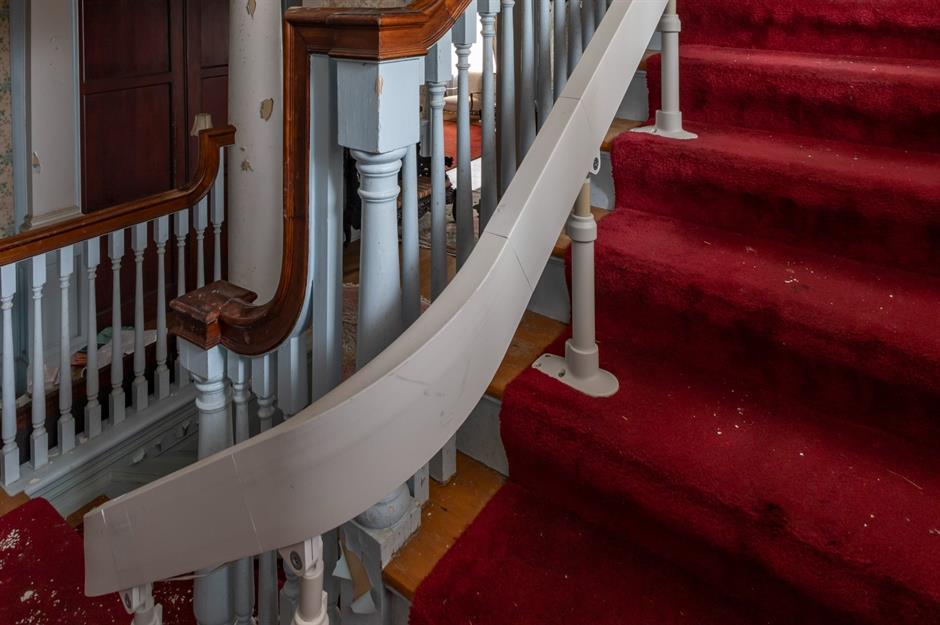
A close view of the intricately carved blue spindles on the staircase, framed by the pleasing curve of the wooden banister, reveals the fine craftsmanship. However, the general state of neglect is evident, with crumbling paint scattered across the red carpet on the stairs. Carolyn Smith passed away in 2003, but Ollie Smith continued to reside in the mansion until his death in 2016.
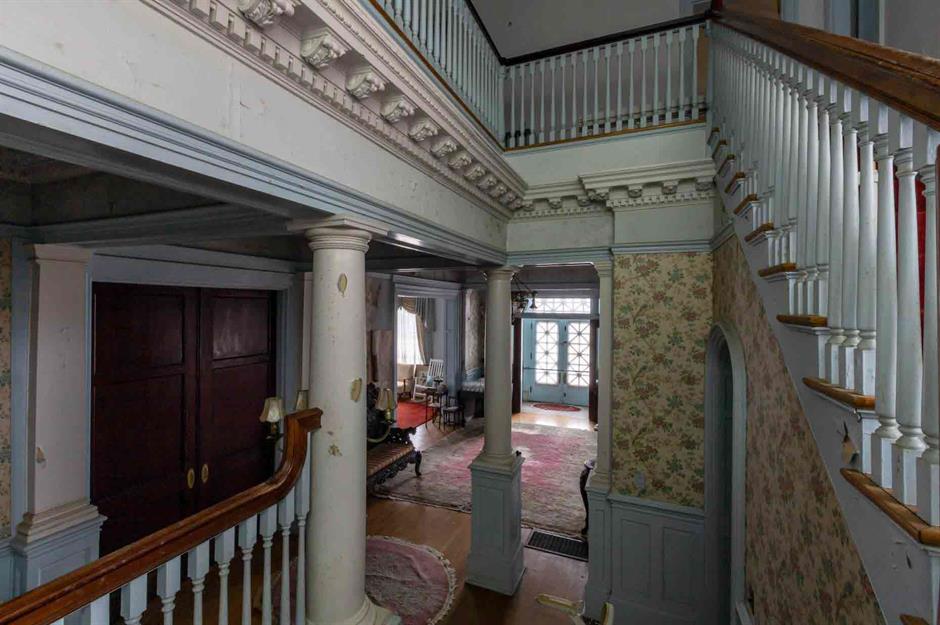
Observe the fine cornicing around the staircase, intricately designed to echo the top of an ornate Corinthian column. This detailing sharply contrasts with the peeling walls, serving as a poignant reminder of the house’s sad neglect. In 2022, the property underwent a transfer within the family to a limited liability company, as reported by Abandoned Southeast.
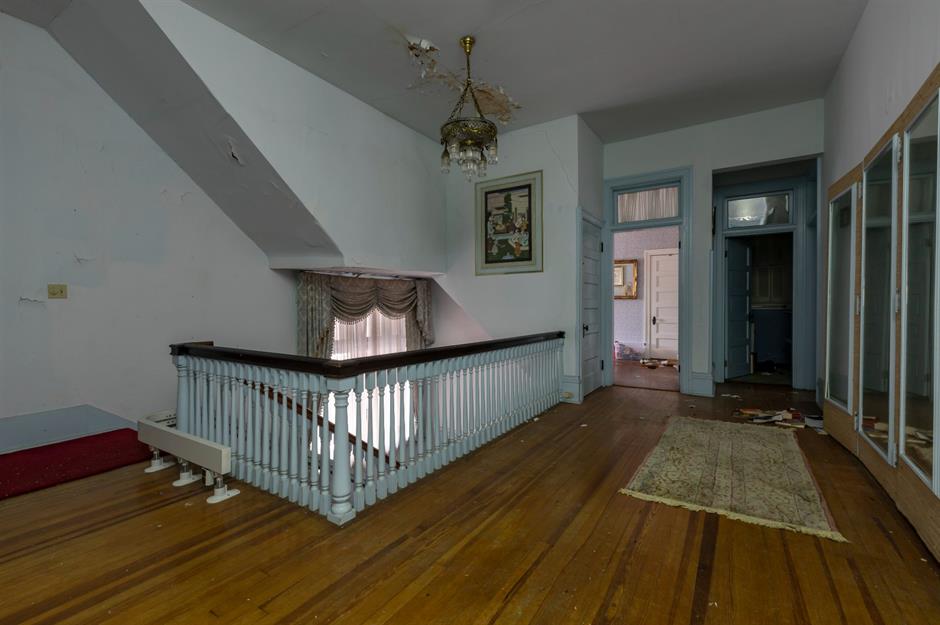
On the upper landing, the once-fine chandelier now appears perilously close to falling, as the ceiling bears the unmistakable signs of severe damp. A large mirrored storage unit stands on the right, while a Japanese-style art piece adorns the staircase, possibly chosen by Ollie and Carolyn during their time in the mansion. Despite its current state, Glen Iris, the neighborhood where the mansion is situated, remains desirable. However, urban expansion over the years has altered the area’s character since the house’s construction in the early 1900s.
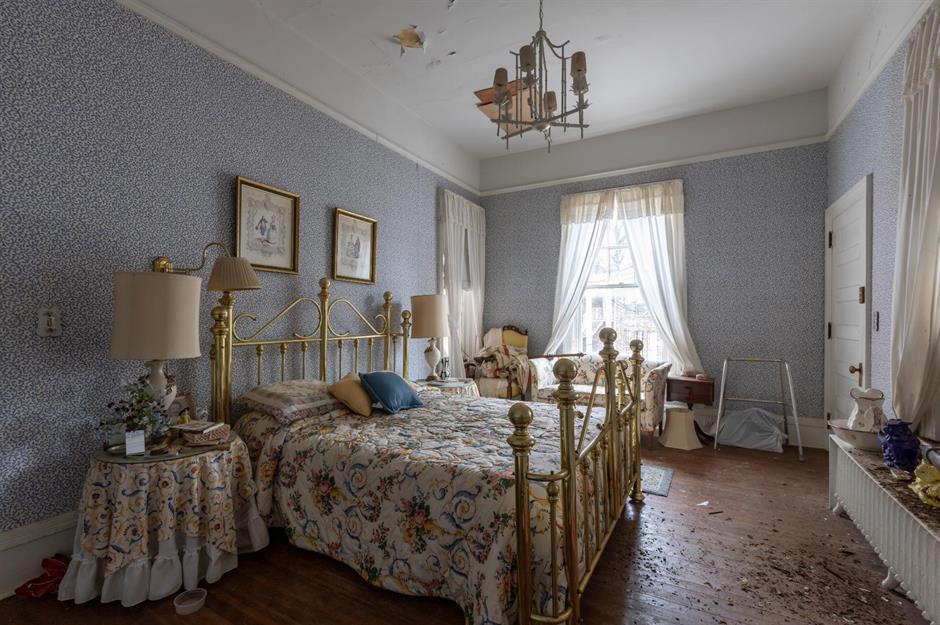
The master bedroom, of a reasonable size, showcases a palatial gold-framed bed and expansive windows. Elegant furniture, including a floral-print sofa matching the comforter and table skirt, adds to the room’s charm. Intriguing animal figurines find their place on the radiator. Unfortunately, the room’s fabric is deteriorating, and debris from wood and plaster is scattered across the floor. Regrettably, this narrative of neglect echoes throughout the neighborhood, with historic mansions in Glen Iris being demolished to make way for new apartments and office blocks.

The shift in construction trends can be traced back to the 1920s when a surge in demand for apartments, driven by changing social dynamics, led to the demolition or conversion of many grand estates. Some of the large old homes were transformed into multi-unit housing during the 1930s and 1940s. In this bedroom shot, prints or drawings hang above the bed, complemented by smart table lamps on either side. The unusual and attractive pendant light fitting features floral-shaped metalwork under each lightbulb.
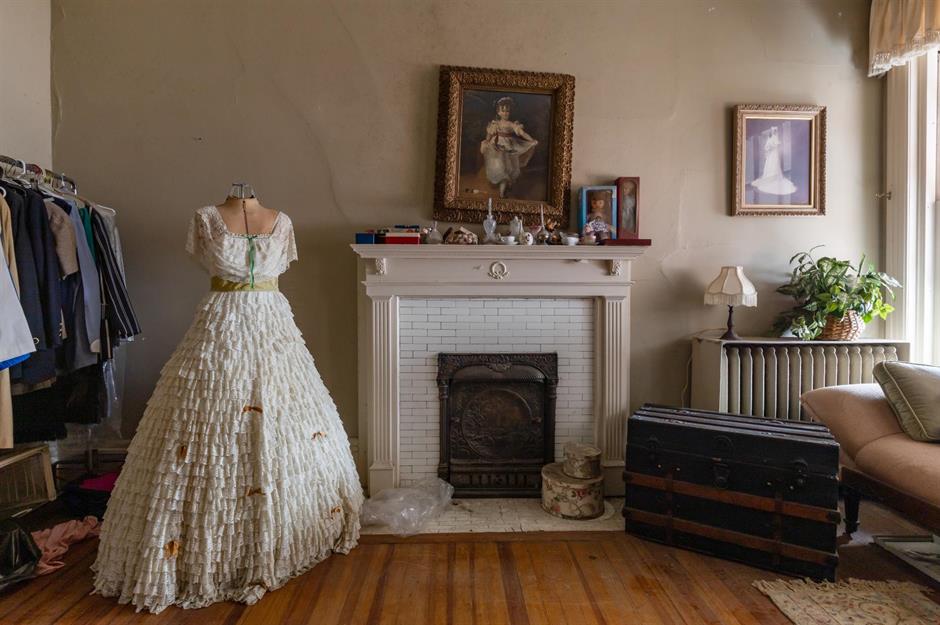
One of the mansion’s most unusual remnants is a beautiful white multi-tiered dress, seemingly awaiting a bride in one of the upstairs rooms. Beside it, a rack of men’s suits hangs. The fireplace design mirrors the neoclassical columns on the home’s exterior, displaying a striking pastoral scene in metal at its center. To the right on the plinth, a photo of a mysterious bride is placed, while an oil painting of a young girl graces the space over the fireplace.
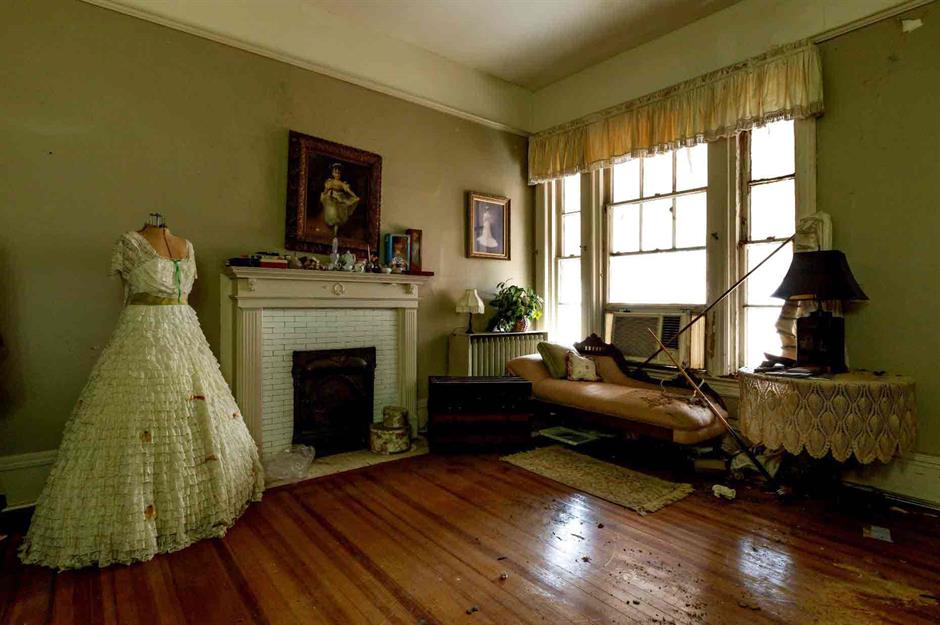
Beneath the window, a chaise longue exudes elegance, despite rips in its fabric and the incongruous fan unit set into the window above. The frilly curtain pelmet and tablecloth suggest that this space, which could have served as a dressing room or another bedroom, was originally designed with meticulous attention to detail.
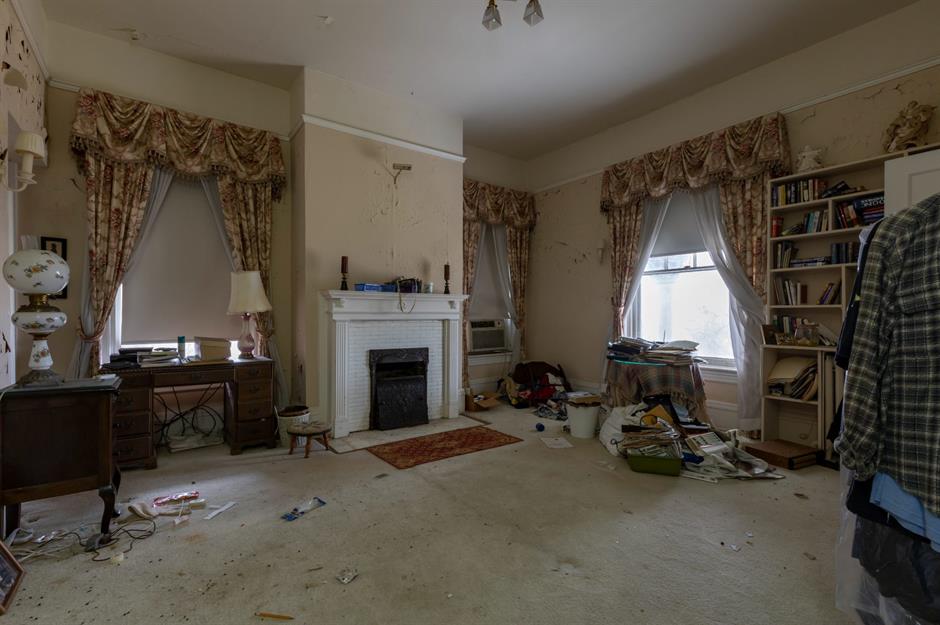
The third sizable bedroom, although missing its bed, retains a dark wood chest of drawers and a desk. The floor-length curtains, adorned with swagged pelmets, and a charming ceramic lamp with a floral pattern add to the room’s aesthetic. Remarkably, books still grace the shelves of the bookcase, offering tangible traces of a bygone life. Unfortunately, the room shares the same fate as the rest of the house, with peeling walls and scattered debris.
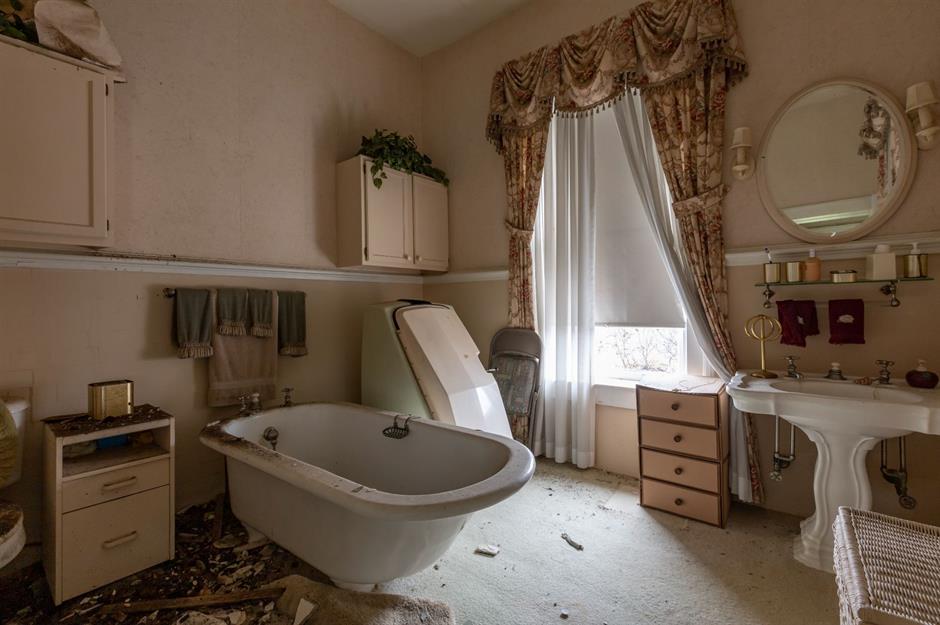
This ensuite bathroom presents a stark contrast between its two halves. One side suffers from significant floor damage, while the other remains relatively unscathed, featuring an ornate basin and a glass shelf holding soap, tissues, and even a solitary toothbrush, as if its owner had momentarily stepped away.
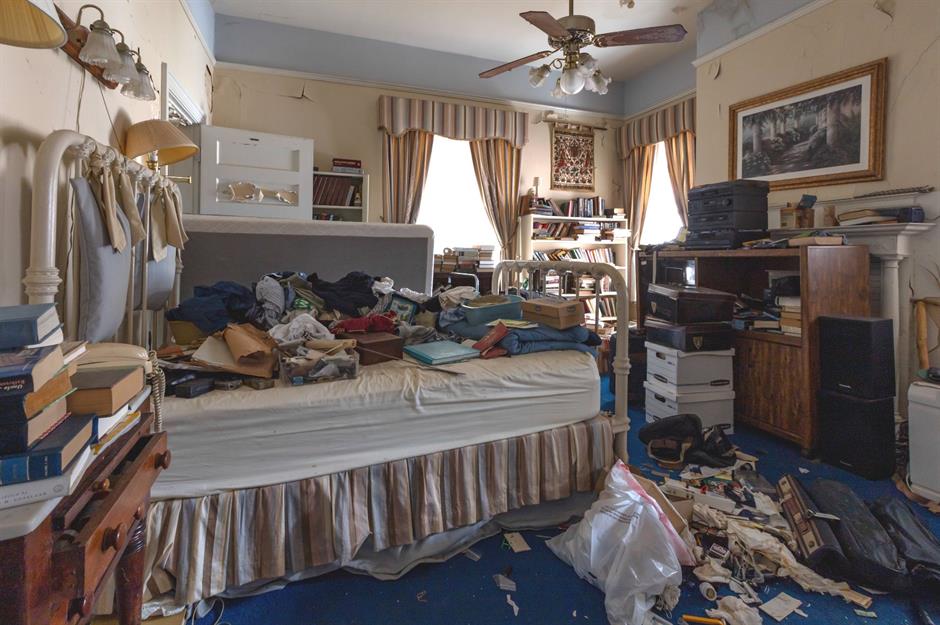
In another bedroom, clothing and belongings lie scattered across the bed and floor, and piles of books gather dust on the bedside table. Despite the disarray, this room exudes a more modern feel compared to the others, albeit still distinctly dated. An old-fashioned hi-fi sound system, a curtain pelmet, and an antiquated cord phone beside the bed hint at a departure that seemed to have happened in haste.
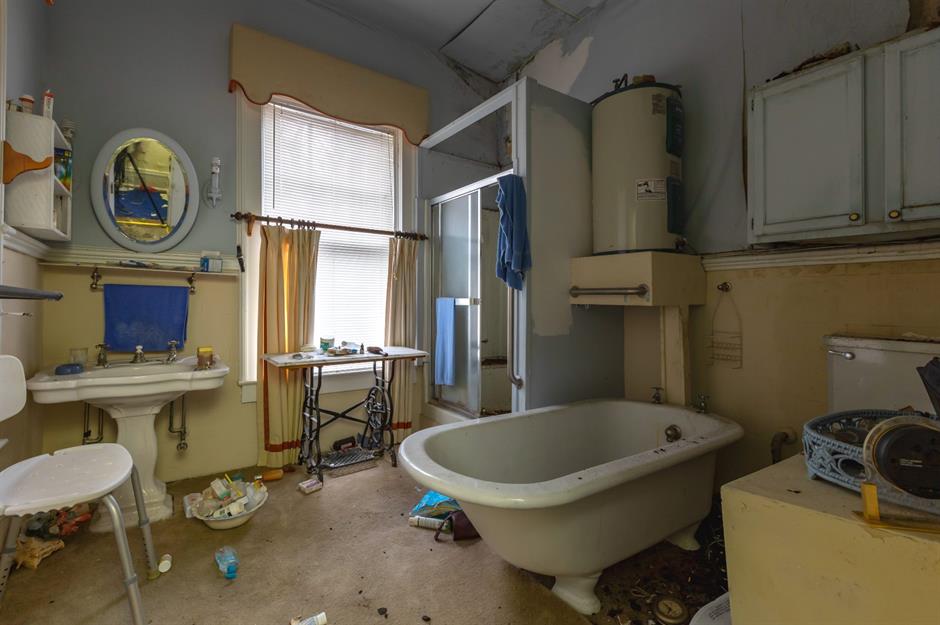
Regrettably, the ensuite bathroom is succumbing to rot around the freestanding bathtub and across the ceiling. The discordant combination of yellow and blue walls, along with light brown carpet, creates an unusual atmosphere. A basket of empty medication tubs is carelessly dumped on the floor, while soap and a dirty towel sit by the sink. Strangely, the table near the window appears to be an antique-style sewing machine bench.
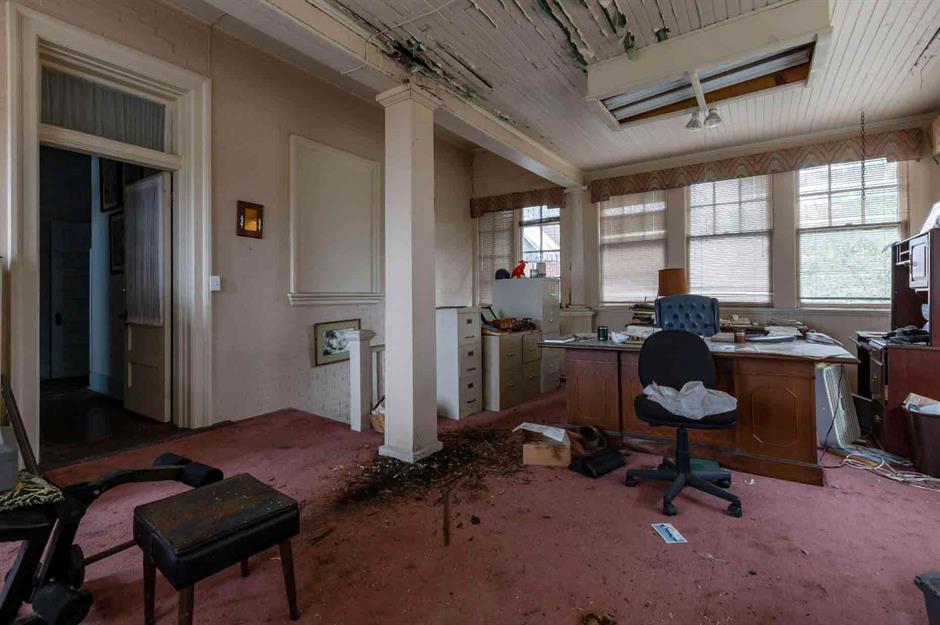
In a grand home office, the ceiling is collapsing, yet a veneer of grandeur persists with a neoclassical-style internal column, smart blinds, a stately wooden desk, and an executive chair. The issue of property neglect by absentee owners poses a significant problem in the area, as noted by Abandoned Southeast. In extreme cases, it can lead to what is termed as “demolition by neglect.”
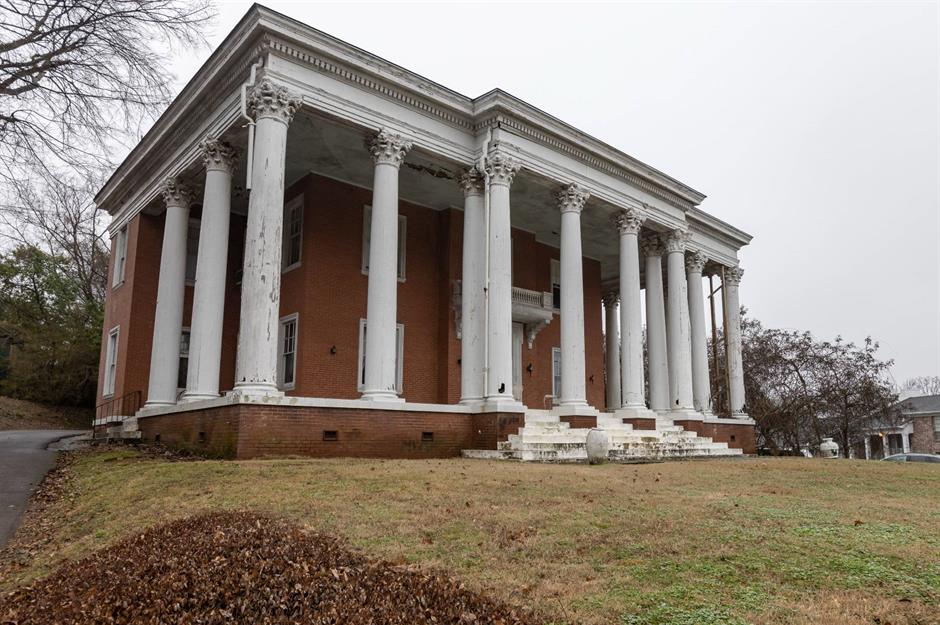
Outside, the grandeur of the entire structure becomes apparent, offering a better view of the red brick behind the columns. A projecting balcony over the entrance on the first floor adds to the architectural charm. Advocating for historic building preservation, the Birmingham Historical Society emphasizes the exceptional significance of Glen Iris Park, urging protection from redevelopment. Hopefully, this remarkable mansion can be saved from neglect and restored to its former glory.
RECOMMENDED: The Historical Rockwell House Renovated And Opened To Public